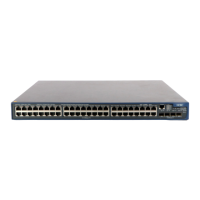1-30
These two commands apply to CIST and MSTIs. If you configure the link to which a port is connected to
be a point-to-point link (or a non-point-to-point link), the configuration applies to all MSTIs (that is, the
port is configured to connect to a point-to-point link (or a non-point-to-point link) in all MSTIs). If the
actual physical link is not a point-to-point link and you configure the link to which the port is connected to
be a point-to-point link, loops may temporarily occur.
Related commands: stp point-to-point.
Examples
# Configure the link connected to Ethernet 1/0/3 as a point-to-point link.
<Sysname> system-view
System View: return to User View with Ctrl+Z.
[Sysname] stp interface Ethernet 1/0/3 point-to-point force-true
stp interface port priority
Syntax
stp interface interface-list instance instance-id port priority priority
undo stp interface interface-list instance instance-id port priority
View
System view
Parameters
interface-list: Ethernet port list. You can specify multiple Ethernet ports by providing this argument in the
form of interface-list = { interface-type interface-number [ to interface-type interface-number ] } &<1-10>,
where &<1-10> means that you can provide up to 10 port indexes/port index ranges for this argument.
instance-id: MSTI ID ranging from 0 to 16. The value of 0 refers to the CIST.
priority: Port priority to be set. This argument ranges from 0 to 240 and must be a multiple of 16 (such as
0, 16, 32, and so on).
Description
Use the stp interface port priority command to set a port priority for the specified ports in the specified
MSTI in system view.
Use the undo stp interface port priority command to restore the default priority of the specified ports
in the specified MSTI in system view.
The default port priority of a port in an MSTI is 128.
If you specify the instance-id argument to 0, the two commands apply to the port priorities on the CIST.
The role a port plays in an MSTI is affected by its port priority in the instance. A port on an
MSTP-enabled switch can have different port priorities and play different roles in different MSTIs. This
enables packets of different VLANs to be forwarded along different physical paths, so as to implement
VLAN-based load balancing. Changing port priorities results in port role recalculation and may cause
state transition.
Related commands: stp port priority.

